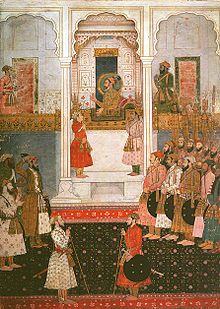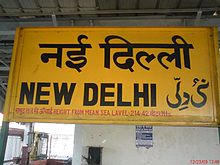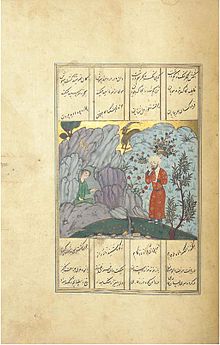
Urdu
Did you know...
SOS Children, which runs nearly 200 sos schools in the developing world, organised this selection. Sponsoring children helps children in the developing world to learn too.
| Urdu | ||||
|---|---|---|---|---|
| اردو | ||||
 Urdu in Perso-Arabic script ( Nastaʿlīq style) |
||||
| Pronunciation | Hindustani: [ˈʊrd̪u] | |||
| Native to | Pakistan, India, Bangladesh ("Bihari"), Nepal | |||
| Native speakers |
66 million (2007) |
|||
| Language family |
Indo-European
|
|||
| Writing system | Arabic ( Urdu alphabet [ Nastaʿlīq]) Devanagari Urdu Braille |
|||
| Official status | ||||
| Official language in | ||||
| Regulated by | National Language Authority (Pakistan); National Council for Promotion of Urdu Language (India) |
|||
| Language codes | ||||
| ISO 639-1 | ur | |||
| ISO 639-2 | urd | |||
| ISO 639-3 | urd | |||
| Linguasphere | 59-AAF-q (with Hindi, including 58 varieties: 59-AAF-qaa to 59-AAF-qil) |
|||
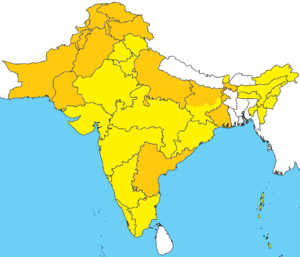 Areas where Urdu is official or coofficial
(Other) areas where Hindi is official
|
||||
|
||||
Urdu / ˈ ʊər d uː / (اُردُو [ˈʊrd̪u]), or more precisely Standard Urdu, is a South Asian language in the Indo-Aryan branch in the Indo-European family of languages. It is the national language and lingua franca of Pakistan. It is also an official language of five Indian states and one of the 22 scheduled languages in the Constitution of India.
Based on the Khariboli dialect of Delhi, Urdu developed under the influence of Persian, Arabic, and Turkic languages over the course of almost 900 years. It originated in the region of Uttar Pradesh in the Indian subcontinent during the Delhi Sultanate (1206–1527), and continued to develop under the Mughal Empire (1526–1858). Urdu is mutually intelligible with Standard Hindi spoken in India. Both languages share the same Indo-Aryan base, and are so similar in basic structure, grammar and to a large extent vocabulary and phonology, that they appear to be one language. The combined population of Urdu and Standard Hindi speakers is the fourth largest in the world.
Mughals hailed from the Barlas tribe which was of Mongol origin, the tribe had embraced Turkic and Persian culture, and resided in Turkestan and Khorasan. Their mother tongue was the Chaghatai language (known to them as Turkī, "Turkic") and they were equally at home in Persian, the lingua franca of the Timurid elite. But after their arrival in the Indian subcontinent, the need to communicate with local inhabitants led to use of Indo-Aryan languages written in the Persian alphabet, with some literary conventions and vocabulary retained from Persian and Turkic; this eventually became a new standard called Hindustani, which is the direct predecessor of Urdu.
Origin of Urdu
The word Urdu is derived from the same Turkish word that has given English horde.
Since the establishment of the Delhi Sultanate and the Mughal Empire until the British Raj, Hindustani, written in the Urdu script, was the language of both Hindus and Muslims. The language was variously known as Hindi, Hindavi, Urdu, and Dehlavi. The communal nature of the language lasted until it replaced Persian as the official language in 1837 and was made coofficial along with English. This triggered a Hindu backlash in northwestern India, which argued that the language should be written in the native Devanagari script. Thus a new literary register, called simply "Hindi", replaced traditional Hindustani as the official language of Bihar in 1881, establishing a sectarian divide of "Urdu" for Muslims and "Hindi" for Hindus, a divide that was formalized with the division of India and Pakistan after independence (though there are Hindu poets who continue to write in Urdu to this day). At independence, Pakistan established a highly Persianized literary standard of Urdu as it official language.
Although there have been attempts to "purify" Urdu and Hindi by purging them of, respectively, their Sanskrit and Persian loan words, and new vocabulary draws primarily from Persian and Arabic for Urdu and from Sanskrit for Hindi, this has primarily affected academic and literary vocabulary, and both national standards remain heavily influenced by both Persian and Sanskrit. English has exerted a heavy influence on both as a coofficial language.
Speakers and geographic distribution
There are between 60 and 70 million native speakers of Urdu: there were 52 million in India per the 2001 census, some 6% of the population; 13 million in Pakistan in 2008, or 8%; and several hundred thousand in the United Kingdom, Saudi Arabia, United States, and Bangladesh, where it is called "Bihari". However, a knowledge of Urdu allows one to speak with far more people than that, as Hindi-Urdu is the fourth most commonly spoken language in the world, after Mandarin, English, and Spanish.
Owing to interaction with other languages, Urdu has become localized wherever it is spoken, including in Pakistan itself. Urdu in Pakistan has undergone changes and has lately incorporated and borrowed many words from Pakistani languages like Pashto, Punjabi, Sindhi and Balti as well as former East Pakistan (now Bangladesh) Bengali language, thus allowing speakers of the language in Pakistan to distinguish themselves more easily and giving the language a decidedly Pakistani flavour. Similarly, the Urdu spoken in India can also be distinguished into many dialects like Dakhni ( Deccan) of South India, and Khariboli of the Punjab region since recent times. Because of Urdu's similarity to Hindi, speakers of the two languages can easily understand one another if both sides refrain from using specialized vocabulary. The syntax (grammar), morphology, and the core vocabulary are essentially identical. Thus linguists usually count them as one single language and contend that they are considered as two different languages for socio-political reasons. In Pakistan Urdu is mostly learned as a second or a third language as nearly 93% of Pakistan's population has a mother tongue other than Urdu. Despite this, Urdu was chosen as a token of unity and as a lingua franca so as not to give any native Pakistani language preference over the other. Urdu is therefore spoken and understood by the vast majority in some form or another, including a majority of urban dwellers in such cities as Karachi, Lahore, Sialkot, Rawalpindi, Islamabad, Multan, Faisalabad, Hyderabad, Peshawar, Quetta, Jhang, Sargodha and Skardu. It is written, spoken and used in all provinces/territories of Pakistan despite the fact that the people from differing provinces may have different indigenous languages, as from the fact that it is the "base language" of the country. For this reason, it is also taught as a compulsory subject up to higher secondary school in both English and Urdu medium school systems. This has produced millions of Urdu speakers from people whose mother tongue is one of the State languages of Pakistan such as Punjabi, Pashto, Sindhi, Balochi, Potwari, Hindko, Pahari, Saraiki, Balti, and Brahui who can read and write only Urdu. It is absorbing many words from the regional languages of Pakistan. This variation of Urdu is sometimes referred to as Pakistani Urdu. So while most of the population is conversant in Urdu, it is the first language only of an estimated 7% of the population, mainly Muslim immigrants (known as Muhajir in Pakistan) from different parts of the Indian subcontinent (India, Burma, Bangladesh etc.). The regional languages are also being influenced by Urdu vocabulary. There are millions of Pakistanis whose mother tongue is not Urdu, but since they have studied in Urdu medium schools, they can read and write Urdu along with their native language. Most of the nearly five million Afghan refugees of different ethnic origins (such as Pashtun, Tajik, Uzbek, Hazarvi, and Turkmen) who stayed in Pakistan for over twenty-five years have also become fluent in Urdu. With such a large number of people(s) speaking Urdu, the language has in recent years acquired a peculiar Pakistani flavour further distinguishing it from the Urdu spoken by native speakers and diversifying the language even further.
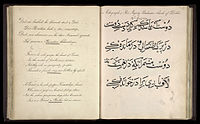
A great number of newspapers are published in Urdu in Pakistan, including the Daily Jang, Nawa-i-Waqt, Millat, among many others (see List of newspapers in Pakistan#Urdu language Newspapers).
In India, Urdu is spoken in places where there are large Muslim minorities or cities which were bases for Muslim Empires in the past. These include parts of Uttar Pradesh, Madhya Pradesh, Bihar, Andhra Pradesh, Maharashtra ( Marathwada), Karnataka and cities namely Lucknow, Delhi, Bareilly, Meerut, Saharanpur, Muzaffarnagar, Roorkee, Deoband, Moradabad, Azamgarh, Bijnor, Najibabad, Rampur, Aligarh, Allahabad, Gorakhpur, Agra, Kanpur, Badaun, Bhopal, Hyderabad, Aurangabad, Bengaluru, Kolkata, Mysore, Patna, Gulbarga, Nanded, Bidar, Ajmer, and Ahmedabad. Some Indian schools teach Urdu as a first language and have their own syllabus and exams. Indian madrasahs also teach Arabic as well as Urdu. India has more than 3,000 Urdu publications including 405 daily Urdu newspapers. Newspapers such as Sahara Urdu, Daily Salar, Hindustan Express, Daily Pasban, Siasat Daily, The Munsif Daily and Inqilab are published and distributed in Bengaluru, Mysore, Hyderabad, and Mumbai (see List of newspapers in India).
Outside South Asia, it is spoken by large numbers of migrant South Asian workers in the major urban centres of the Persian Gulf countries and Saudi Arabia. Urdu is also spoken by large numbers of immigrants and their children in the major urban centres of the United Kingdom, the United States, Canada, Germany, Norway, and Australia. Along with Arabic, Urdu is among the immigrant languages with the most speakers in Catalonia, leading to fears of linguistic ghettos.
Official status
Urdu is the national and one of the two official languages of Pakistan, the other being English, and is spoken and understood throughout the country, while the state-by-state languages (languages spoken throughout various regions) are the provincial languages. Only 8% of Pakistanians speak only Urdu. It is used in education, literature, office and court business. It holds in itself a repository of the cultural and social heritage of the country. Although English is used in most elite circles, and Punjabi has a plurality of native speakers, Urdu is the lingua franca and national language in Pakistan.
Urdu is also one of the officially recognised languages in India and has official language status in the Indian states of Uttar Pradesh, Bihar, Andhra Pradesh, Jharkhand, Uttarakhand, Jammu and Kashmir and the national capital, New Delhi.
In Jammu and Kashmir, section 145 of the Kashmir Constitution provides: "The official language of the State shall be Urdu but the English language shall unless the Legislature by law otherwise provides, continue to be used for all the official purposes of the State for which it was being used immediately before the commencement of the Constitution."
The importance of Urdu in the Muslim world is visible in the Holy cities of Mecca and Medina in Saudi Arabia, where most informational signage is written in Arabic, English and Urdu, and sometimes in other languages.
Dialects
Urdu has a few recognised dialects, including Dakhni, Rekhta, and Modern Vernacular Urdu (based on the Khariboli dialect of the Delhi region). Dakhni (also known as Dakani, Deccani, Desia, Mirgan) is spoken in Deccan region of southern India. It is distinct by its mixture of vocabulary from Marathi and Konkani, as well as some vocabulary from Arabic, Persian and Turkish that are not found in the standard dialect of Urdu. Dakhini is widely spoken in all parts of Maharashtra, Andhra Pradesh and Karnataka. Urdu is read and written as in other parts of India. A number of daily newspapers and several monthly magazines in Urdu are published in these states. In terms of pronunciation, the easiest way to recognize a native speaker is their pronunciation of the letter "qāf" (ﻕ) as "kh" (ﺥ).
The Pakistani variant of the language becomes increasingly divergent from the Indian dialects and forms of Urdu, as it has absorbed many loan words, proverbs and phonetics from Pakistan's indigenous languages such as Pashto, Panjabi and Sindhi. Furthermore, due to the region's history, the Urdu dialect of Pakistan draws heavily from the Persian and Arabic languages, and the intonation and pronunciation are more formal compared with corresponding Indian dialects.
In addition, Rekhta (or Rekhti), the language of Urdu poetry, is sometimes counted as a separate dialect, one famously used by several poets of high acclaim in the bulk of their work. These included Mirza Ghalib, Mir Taqi Mir and Muhammad Iqbal.
Urdu spoken in Indian state of Odisha is different from Urdu spoken in other areas; it is a mixture of Oriya and Bihari.
Urdu and Hindi
Urdu is often contrasted with Hindi. Apart from religious associations, the differences are largely restricted to the standard forms: Standard Urdu is conventionally written in the Nastaliq style of the Persian alphabet and relies heavily on Persian and Arabic as a source for technical and literary vocabulary, whereas Standard Hindi is conventionally written in Devanāgarī and draws on Sanskrit. However, both have large numbers of Arabic, Persian and Sanskrit words, and most linguists consider them to be two standardized forms of the same language, and consider the differences to be sociolinguistic, though a few classify them separately. Mutual intelligibility decreases in literary and specialized contexts which rely on educated vocabulary. Due to religious nationalism since the partition of British India and continued communal tensions, native speakers of both Hindi and Urdu frequently assert them to be distinct languages, despite the numerous similarities between the two in a colloquial setting. However, it is quite easy in a longer conversation to distinguish differences in vocabulary and pronunciation of some Urdu phonemes.
Phonology
Grammar
Vocabulary
Urdu has a vocabulary rich in words with and Middle Eastern origins. The language's Indo-Aryan base has been enriched by borrowing from Persian and Arabic. There are also a smaller number of borrowings from Chagatai, Portuguese, and more recently English. Many of the words of Arabic origin have been adopted through Persian and have different pronunciations and nuances of meaning and usage than they do in Arabic.
Levels of formality
Urdu in its less formalised register has been referred to as a rekhta (ریختہ, [reːxt̪aː]), meaning "rough mixture". The more formal register of Urdu is sometimes referred to as zabān-e-Urdu-e-mo'alla (زبان اردو معلہ [zəbaːn eː ʊrd̪uː eː moəllaː]), the "Language of the Exalted Camp", referring to the Imperial army.
The etymology of the word used in the Urdu language for the most part decides how polite or refined one's speech is. For example, Urdu speakers would distinguish between پانی pānī and آب āb, both meaning "water" for example, or between آدمی ādmi and مرد mard, meaning "man". The former in each set is used colloquially and has older Hindustani origins, while the latter is used formally and poetically, being of Persian origin.
If a word is of Persian or Arabic origin, the level of speech is considered to be more formal and grand. Similarly, if Persian or Arabic grammar constructs, such as the izafat, are used in Urdu, the level of speech is also considered more formal and grand. If a word is inherited from Sanskrit, the level of speech is considered more colloquial and personal.
That distinction has likenesses with the division between words from Latin and French or those of Old English origin while speaking English.
Politeness
Urdu syntax and vocabulary reflect a three tiered system of politeness called ādāb. Due to its emphasis on politeness and propriety, Urdu has always been considered an elevated, somewhat aristocratic, language in South Asia. It continues to conjure a subtle, polished affect in South Asian linguistic and literary sensibilities and thus continues to be preferred for song-writing and poetry, even by non-native speakers.
Any verb can be conjugated as per three or four different tiers of politeness. For example, the verb to speak in Urdu is bolnā (بولنا) and the verb to sit is baiţhnā (بیٹھنا). The imperatives "speak!" and "sit!" can thus be conjugated five different ways, each marking subtle variation in politeness and propriety. These permutations exclude a host of auxiliary verbs and expressions which can be added to these verbs to add even greater degree of subtle variation. For extremely polite or formal situations, nearly all commonly used verbs have equivalent formal synonyms (Row 5 below). The phrase category '[āp] bolo', mentioned in Row 3 below, is associated with the Punjabi usage 'tusi bolo' and is rarely used in written Urdu. It is considered grammatically incorrect, particularly in the Gangetic Plain, where the influence of Punjabi on Urdu is minimal.
| Literary* | [tu] bol! | تو بول | [tu] baiţh! | تو بیٹھ |
| Casual and intimate | [tum] bolo. | تم بولو | [tum] baiţho | تم بیٹھو |
| Polite and intimate | [āp] bolo | آپ بولو | [āp] baiţho. | آپ بیٹھو |
| Formal yet intimate | [āp] bolen | آپ بولیں | [āp] baiţhen. | آپ بیٹھیں |
| Polite and formal | [āp] bolīye | آپ بولیئے | [āp] baiţhīye. | آپ بیٹھیئے |
| Ceremonial / Extremely formal | [āp] farmaīye | آپ فرمایئے | [āp] tašrīf-rakhīye. | آپ تشریف رکھیئے |
Similarly, nouns are also marked for politeness and formality. For example, uskī vālida, "his mother" is a politer way of say uskī ammī. Uskī vālida-mohtarmā is an even more polite reference, while saying uskī mān would be construed as derogatory. None of these forms are slang or shortenings, and all are encountered in writing.
Expressions are also marked for politeness. For example, the expression "No!" could be nā, nahīn or jī-nahīn in order of politeness. Similarly, "Yes!" can be hān-jī, hān, jī or jī-hān in order of politeness.
Writing system
Urdu script
Urdu is written right-to left in an extension of the Persian alphabet, which is itself an extension of the Arabic alphabet. Urdu is associated with the Nastaʿlīq style of Persian calligraphy, whereas Arabic is generally written in the Naskh or Ruq'ah styles. Nasta’liq is notoriously difficult to typeset, so Urdu newspapers were hand-written by masters of calligraphy, known as katib or khush-navees, until the late 1980s. One handwritten Urdu newspaper, The Musalman, is still published daily in Chennai.
Kaithi script
Urdu was also written in the Kaithi script. A highly Persianized and technical form of Urdu was the lingua franca of the law courts of the British administration in Bengal, Bihar, and the North-West Provinces & Oudh. Until the late 19th century, all proceedings and court transactions in this register of Urdu were written officially in the Persian script. In 1880, Sir Ashley Eden, the Lieutenant-Governor of Bengal abolished the use of the Persian alphabet in the law courts of Bengal and Bihar and ordered the exclusive use of Kaithi, a popular script used for both Urdu and Hindi. Kaithi's association with Urdu and Hindi was ultimately eliminated by the political contest between these languages and their scripts, in which the Persian script was definitively linked to Urdu.
Devanagari script
More recently in India, Urdu speakers have adopted Devanagari for publishing Urdu periodicals and have innovated new strategies to mark Urdū in Devanagari as distinct from Hindi in Devanagari. Such publishers have introduced new orthographic features into Devanagari for the purpose of representing the Perso-Arabic etymology of Urdu words. One example is the use of अ (Devanagari a) with vowel signs to mimic contexts of ع ( ‘ain), in violation of Hindi orthographic rules. For Urdu publishers, the use of Devanagari gives them a greater audience, while the orthographic changes help them preserve a distinct identity of Urdu.
Roman script
Urdu is occasionally also written in the Roman script. Roman Urdu has been used since the days of the British Raj, partly as a result of the availability and low cost of Roman movable type for printing presses. The use of Roman Urdu was common in contexts such as product labels. Today it is regaining popularity among users of text-messaging and Internet services and is developing its own style and conventions. Habib R. Sulemani says, "The younger generation of Urdu-speaking people around the world, especially Pakistan, are using Romanised Urdu on the Internet and it has become essential for them, because they use the Internet and English is its language. Typically, in that sense, a person from Islamabad in Pakistan may chat with another in Delhi in India on the Internet only in Roman Urdū. They both speak the same language but would have different scripts. Moreover, the younger generation of those who are from the English medium schools or settled in the west, can speak Urdu but can’t write it in the traditional Arabic script and thus Roman Urdu is a blessing for such a population." Roman Urdu also holds significance among the Christians of Pakistan and North India. Urdū was the dominant native language among Christians of Karachi and Lahore in present-day Pakistan and Madhya Pradesh, Uttar Pradesh Rajasthan in India, during the early part of the nineteenth and twentieth century, and is still used by Christians in these places. Pakistani and Indian Christians often used the Roman script for writing Urdū. Thus Roman Urdū was a common way of writing among Pakistani and Indian Christians in these areas up to the 1960s. The Bible Society of India publishes Roman Urdū Bibles which enjoyed sale late into the 1960s (though they are still published today). Church songbooks are also common in Roman Urdū. However, the usage of Roman Urdū is declining with the wider use of Hindi and English in these states.
Uddin and Begum Urdu-Hindustani romanization
Uddin and Begum Urdu-Hindustani Romanization is another system for Hindustani. It was proposed by Syed Fasih Uddin (late) and Quader Unissa Begum (late). As such is adopted by The First International Urdu Conference (Chicago) 1992, as "The Modern International Standard Letters of Alphabet for URDU-(HINDUSTANI) - The INDIAN Language script for the purposes of hand written communication, dictionary references, published material and Computerized Linguistic Communications (CLC)".
There are significant advantages to this transcription system:
- It provides a standard which is based on the original works undertaken at the Fort William College, Calcutta, India (established 1800), under John Borthwick Gilchrist (1789–1841), which has become the de facto standard for Hindustani during the late 1800.
- There is a one-to-one representation for each of the original Urdu-Hindustani characters.
- Vowel sounds are written rather than being assumed as they are in the Urdu alphabet.
- Unlike Gilchrist’s alphabet, which used many special non-ASCII characters, the proposed alphabet only utilizes ASCII.
- Since it is ASCII based, more resources and tools are available.
- Liberate Urdu–Hindustani language to be written and communicated utilizing all of the available standards and free us from Unicode conversion drudgery.
- Urdu–Hindustani with this character set fully utilizes paper and electronic print media.
Differences with Persian alphabet
Persian alphabet has been extended for Urdu with additional letters ٹ ,ڈ ,ڑ. In order to make the language suitable for the people of South Asia (mainly Pakistan), two letters ہ and ی have added dimensions in use. ہ is used independently as any other letter in words such as ہم (we) and باہم (mutual). As an extended use, ہ is also used to denote uniquely defined phonetics of South Asian origin. Here it is referred as do-chashmi he and it follows the nearest letters of the Persian alphabet to render the required phonetic. Some example of the words are دھڑکن (heartbeat), بھارت (India). On the other hand ی is used in two vowel forms: Chhoti ye (ی) and Badi ye (ے). Chhoti ye denotes the vowel sound similar to "ea" in the English word beat as in the word ساتھی (companion). Chhoti ye is also used as the Urdu consonant "Y" as in word یار (companion/friend). Badi ye is supposed to give the sound similar to "a" in the word "late" (full vowel sound - not like a diphthong) as in the word کے (of). However, in the written form both badi ye and chhoti ye are same when the vowel falls in the middle of a word and the letters need to be joint according to the rules of the Urdu grammar. Badi ye is also used to play a supporting role for a diphthong sound such as the English "i" as in the word "bite" as in the word مے (wine). However, no difference of ye is seen in words such as کیسا (how) where the vowel comes in the middle of the written word. Similarly the letter و is used to denote vowel sound -oo similar to the word "food" as in لوٹ (loot), "o" similar to the word "vote" as in دو (two) and it is also used as a consonant "w" similar to the word "war" as in وظیفہ (pension). It is also used as a supportive letter in the diphthong construction similar to the "ou" in the word "mount" as in the word کون (who). و is silent in many word of Persian origin such as خواب (dream), خواہش (desire). It has diminutive sound similar to "ou" in words such as "would", "could" as in the words خود (self), خوش (happy). The vowel/accent marks (اعراب) mainly support the core Arabic vowels. Non-Arabic vowels such as -o- in mor مور- (peacock) and the -e- as in Estonia (ایسٹونیا) are referred as مجہول (alien/ignorant phonetics) and hence are not supported by the vowel/accent marks (اعراب). A description of these vowel marks and the word formation in Urdu can be found at this website.
Encoding Urdu in unicode
Like other writing systems derived from the Arabic Script, Urdu uses the 0600-06FF Unicode range. Certain glyphs in this range appear visually similar (or identical when presented using particular fonts) even though the underlying encoding is different. This presents problems for information storage and retrieval. For example, the University of Chicago's electronic copy of John Shakespear's "A Dictionary, Hindustani, and English" includes the word 'بهارت' (India). Searching for the string "بھارت" returns no results, while querying with the (identical-looking in many fonts) string "بهارت" returns the correct entry. This is because the medial form of the Urdu letter do chashmi he (U+06BE) - used to form aspirate digraphs in Urdu - is visually identical in its medial form to the Arabic letter hāʾ (U+0647; phonetic value /h/). In Urdu, the /h/ phoneme is represented by the character U+06C1, called gol he (round he), or chhoti he (small he).
| Characters in Urdu | Characters in Arabic |
|---|---|
| ہ (U+06C1), ھ (U+06BE) | ه (U+0647) |
| ی (U+06CC) | ى (U+0649), ي (U+064A) |
| ک (U+06A9) | ك (U+0643) |
In 2003, the Centre for Research in Urdu Language Processing (CRULP) - a research organization affiliated with Pakistan's National University of Computer and Emerging Sciences - produced a proposal for mapping from the 1-byte UZT encoding of Urdu characters to the Unicode standard. This proposal suggests a preferred Unicode glyph for each character in the Urdu alphabet.
Literature
Urdu has become a literary language only in recent centuries, as Persian was formerly the idiom of choice for the Muslim courts of North India. However, despite its relatively late development, Urdu literature boasts of some world-recognised artists and a considerable corpus.
Prose
Religious
Urdu holds the largest collection of works on Islamic literature and Sharia. These include translations and interpretation of the Qur'an as well as commentary on Hadith, Fiqh, history, spirituality, Sufism and metaphysics. A great number of classical texts from Arabic and Persian have also been translated into Urdu. Relatively inexpensive publishing, combined with the use of Urdu as a lingua franca among Muslims of South Asia, has meant that Islam-related works in Urdu far outnumber such works in any other South Asian language. Popular Islamic books are also written in Urdu.
It is interesting to note that a treatise on Astrology was penned in Urdu by Pandit Roop Chand Joshi in the eighteenth century. The book, known as Lal Kitab, is widely popular in North India among astrologers and was written at a time when Urdu was very much spoken in the Brahmin families of that region.
Literary
Secular prose includes all categories of widely known fiction and non-fiction work, separable into genres. The dāstān, or tale, a traditional story which may have many characters and complex plotting. This has now fallen into disuse.
The afsāna or short story, probably the best-known genre of Urdu fiction. The best-known afsāna writers, or afsāna nigār, in Urdu are Munshi Premchand, Saadat Hasan Manto, Rajinder Singh Bedi, Krishan Chander, Qurratulain Hyder (Qurat-ul-Ain Haider), Ismat Chughtai, Ghulam Abbas, and Ahmad Nadeem Qasimi. Towards the end of last century Paigham Afaqui's novel Makaan appeared with a reviving force for Urdu novel resulting into writing of novels getting a boost in Urdu literature and a number of writers like Ghazanfer, Abdus Samad, Sarwat Khan and Musharraf Alam Zauqi have taken the move forward. Munshi Premchand, became known as a pioneer in the afsāna, though some contend that his were not technically the first as Sir Ross Masood had already written many short stories in Urdu. Novels form a genre of their own, in the tradition of the English novel. Other genres include saférnāma (travel story), mazmoon (essay), sarguzisht (account/narrative), inshaeya (satirical essay), murasela (editorial), and khud navvisht (autobiography).
Poetry
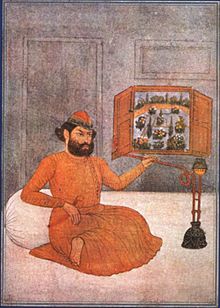
Urdu has been one of the premier languages of poetry in South Asia for two centuries, and has developed a rich tradition in a variety of poetic genres. The Ghazal in Urdu represents the most popular form of subjective music and poetry, while the Nazm exemplifies the objective kind, often reserved for narrative, descriptive, didactic or satirical purposes. Under the broad head of the Nazm we may also include the classical forms of poems known by specific names such as Masnavi (a long narrative poem in rhyming couplets on any theme: romantic, religious, or didactic), Marsia (an elegy traditionally meant to commemorate the martyrdom of Hazrat Husayn ibn Ali, grandson of Muhammad, and his comrades of the Karbala fame), or Qasida (a panegyric written in praise of a king or a nobleman), for all these poems have a single presiding subject, logically developed and concluded. {However, these poetic species have an old world aura about their subject and style, and are different from the modern Nazm, supposed to have come into vogue in the later part of the nineteenth century.
Probably the most widely recited, and memorised genre of contemporary Urdu poetry is nāt—panegyric poetry written in praise of the Prophet Muhammad. Nāt can be of any formal category, but is most commonly in the ghazal form. The language used in Urdu nāt ranges from the intensely colloquial to a highly Persified formal language. The great early 20th century scholar Ala Hazrat, Imam Ahmed Raza Khan Barelvi, who wrote many of the most well known nāts in Urdu (the collection of his poetic work is Hadaiq-e-Baqhshish), epitomised this range in a ghazal of nine stanzas (bayt) in which every stanza contains half a line each of Arabic, Persian, formal Urdu, and colloquial Hindi. The same poet composed a salām—a poem of greeting to the Prophet Muhammad, derived from the unorthodox practice of qiyam, or standing, during the mawlid, or celebration of the birth of the Prophet—Mustafā Jān-e Rahmat, which, due to being recited on Fridays in some Urdu speaking mosques throughout the world, is probably the most frequently recited Urdu poem of the modern era. Another notable nāt natkhwan (writer) is Maulana Shabnam Kamali whose nāts have been widely appreciated and acknowledged.
Another important genre of Urdu prose are the poems commemorating the martyrdom of Husayn ibn Ali(r.a) at the Battle of Karbala, called noha (نوحہ) and marsia. Anees and Dabeer are famous in this regard.
Terminology
Ash'ār (اشعار, couplet). It consists of two lines called Misra (مصرعہ); first line is called مصرع اولی (Misra-e-oola) and the second is called (مصرعہ ثانی) (Misra-e-sānī). Each verse embodies a single thought or subject (singular) شعر She'r.
In the Urdu poetic tradition, most poets use a pen name called the takhallus. This can be either a part of a poet's given name or something else adopted as an identity. The traditional convention in identifying Urdu poets is to mention the takhallus at the end of the name. Thus Ghalib, whose official name and title was Mirza Asadullah Beg Khan, is referred to formally as Mirza Asadullah Khan Ghalib, or in common parlance as just Mirza Ghalib. Because the takhallus can be a part of their actual name, some poets end up having that part of their name repeated, such as Faiz Ahmad Faiz.
The word takhallus is derived from Arabic, meaning "ending". This is because in the ghazal form, the poet would usually incorporate his or her pen name into the final couplet (maqta) of each poem as a type of "signature".
Urdu poetry example
This is Ghalib's famous couplet in which he compares himself to his great predecessor, the master poet Mir:
|
ریختے کے تمہی استاد نہیں ہو غالب
|
||
|
کہتے ہیں پہلے زمانے میں کوئی میر بھی تھا
|
Transliteration
- Rekhte ke tumhiⁿustād nahīⁿ ho Ghālib
- Kahte haiⁿ pehle zamāne meⁿ ko'ī Mīr bhī thā
Translation
- You are not the only master of Rekhta*, Ghalib
- They say that in the past there also was someone named Mir.
- Rekhta was the name for the Urdu/Hindi language in Ghalib's days, when the distinction had not yet been made.
Urdu and Hindi
Urdu and Modern Standard Hindi are considered different languages officially and in the sociolinguistic sense. However, they are not even distinct dialects, but rather different literary styles of a single dialect, Dehlavi. At the colloquial level they are virtually identical, to the point that speakers often cannot tell whether someone is speaking "Hindi" or "Urdu". There are differences in vocabulary depending on the educational level and minor pronunciation differences of some Persian and Arabic sounds, but the grammar is identical, and both styles have heavy Persian and Sanskrit influences. This ambiguous colloquial language is often called Hindustani and is intentionally used in Bollywood films to target a more universal audience, including Pakistan.
In formal and academic registers, however, the differences in vocabulary become substantial, with Urdu drawing from Arabic and Persian, and Hindi from Sanskrit, to the point where they become mutually unintelligible. There is also the convention, generally followed, of Urdu being written in Persio-Arabic script, and Hindi in Devanagari.
These two standardised registers of Hindustani have become so entrenched as separate languages that often nationalists, both Muslim and Hindu, claim that Urdu and Hindi have always been separate languages. There have been some observations that the "fully standardized" Hindi register is artificial enough to make it partially incomprehensible to many people classified as Hindi speakers.
Because of the difficulty in distinguishing between Urdu and Hindi speakers in India and Pakistan, as well as estimating the number of people for whom Urdu is a second language, the estimated number of speakers is uncertain and controversial. Further information is available in the following articles: Hindi-Urdu controversy, Hindustani language, and Hindi.
Phrases
| English | Urdu | Transliteration | Notes |
|---|---|---|---|
| (Hello) Peace be upon you | السلام علیکم | assalāmu ‘alaikum | lit. "Peace be upon you." (from Arabic). Often shortened to 'Salam' |
| (Reply to Salam) Peace be upon you too | و علیکم السلام | waˈalaikum assalām | lit. "And upon you, peace." Response to assalāmu ʿalaikum |
| Hello | (آداب (عرض ہے | ādāb (arz hai) | lit. "Regards (are expressed)", a very formal secular greeting |
| Goodbye | خدا حافظ,الله حافظ | Khuda hāfiz, Allah hāfiz | lit. "May God be your Guardian". "Khuda" from Persian for "God", "Allah" from Arabic for "God" |
| Yes | ہاں | hāⁿ | casual |
| Yes | جی | jī | formal |
| Yes | جی ہاں | jī hāⁿ | confident formal |
| No | نہ | nā | casual |
| No | نہیں، جی نہیں | nahīⁿ, jī nahīⁿ | casual; jī nahīⁿ formal |
| Please | مہربانی | mehrbānī | lit. "kindness" Also used for "thank you" |
| Thank you | شُکریہ | shukrīā | from Arabic shukran |
| Please come in | تشریف لائیے | tashrīf laīe | lit. "(Please) bring your honour" |
| Please have a seat | تشریف رکھیئے | tashrīf rakhīe | lit. "(Please) place your honour" |
| I am happy to meet you | آپ سے مل کر خوشی ہوئی | āp se mil kar khushī hūyī | |
| Do you speak English? | کیا آپ انگریزی بولتے ہیں؟ | kya āp angrezī bolte haiⁿ? | |
| I do not speak Urdu. | میں اردو نہیں بولتا/بولتی | maiⁿ urdū nahīⁿ boltā/boltī | boltā is masculine, boltī is feminine |
| My name is ... | میرا نام ۔۔۔ ہے | merā nām .... hai | |
| Which way to Karachi? | کراچی کس طرف ہے؟ | Karācī kis taraf hai? | lit. "What direction is Karachi in?" |
| Where is Lucknow? | لکھنؤ کہاں ہے؟ | lakhnau kahāⁿ hai | |
| Urdu is a good language. | اردو اچھی زبان ہے | urdū achhī zabān hai |
Software
The Daily Jang was the first Urdu newspaper to be typeset digitally in Nasta’liq by computer. There are efforts underway to develop more sophisticated and user-friendly Urdu support on computers and the Internet. Nowadays, nearly all Urdu newspapers, magazines, journals, and periodicals are composed on computers via various Urdu software programmes, the most widespread of which is InPage Desktop Publishing package. Microsoft has included Urdu language support in all new versions of Windows and both Windows Vista and Microsoft Office 2007 are available in Urdu through Language Interface Pack support. Most Linux Desktop distributions allow the easy installation of Urdu support and translations as well.
Non-secular Character of Urdu
Urdu has some peculiar characteristics where use of certain words is reserved for Muslims. Shaheed (شہید ) is essentially meant to be used for Muslim martyrs and marhoom (مرحوم ) (meaning in position of mercy - Urdu equivalent of "late") is to be used only before Muslim names. On the other hand, the word used to describe a dead non-Muslim is anjahani (آنجہانی), a Persian coinage and it means the deceased person belongs to the other world. If somebody describes a dead Muslim as anjahani, that person is most likely to be rebuked.

